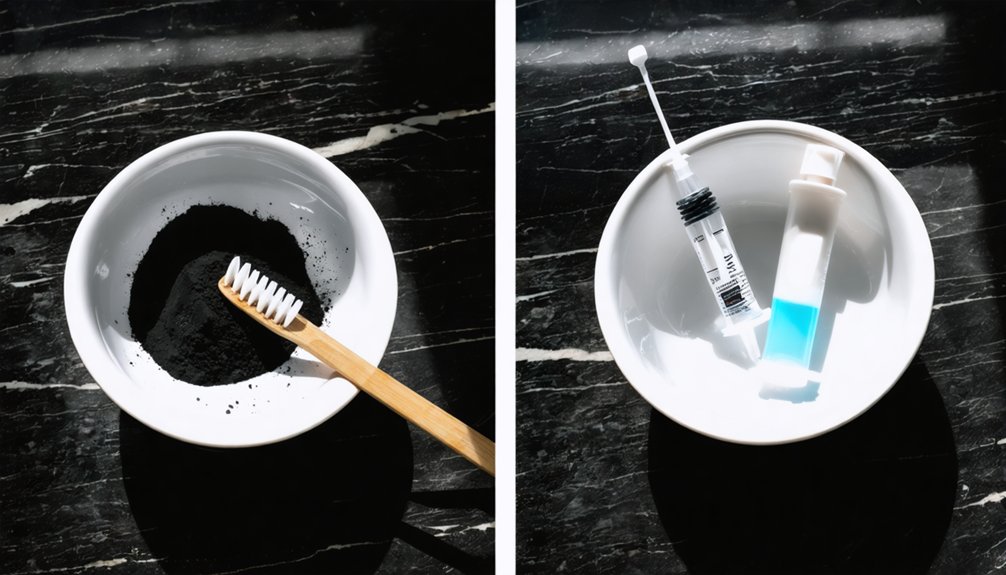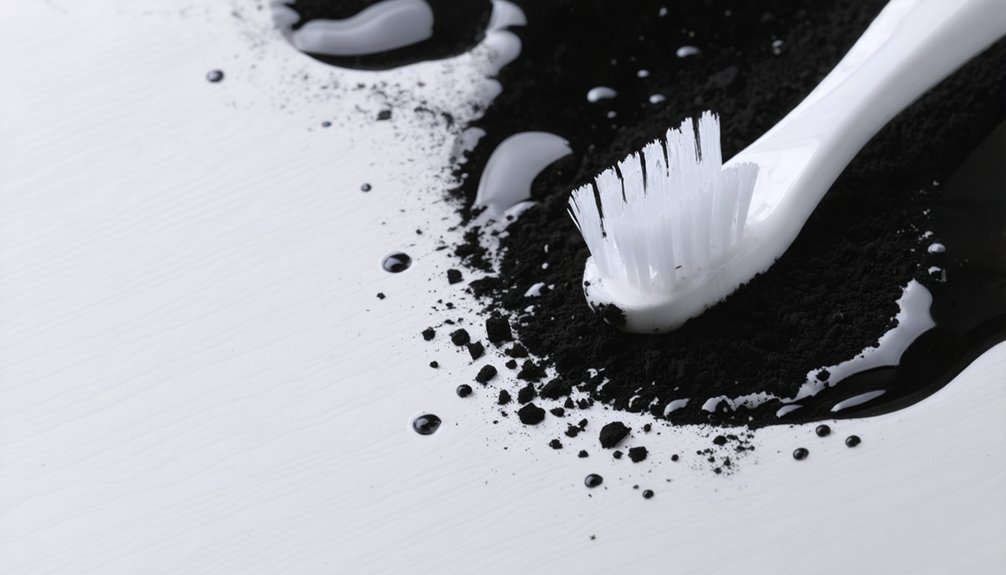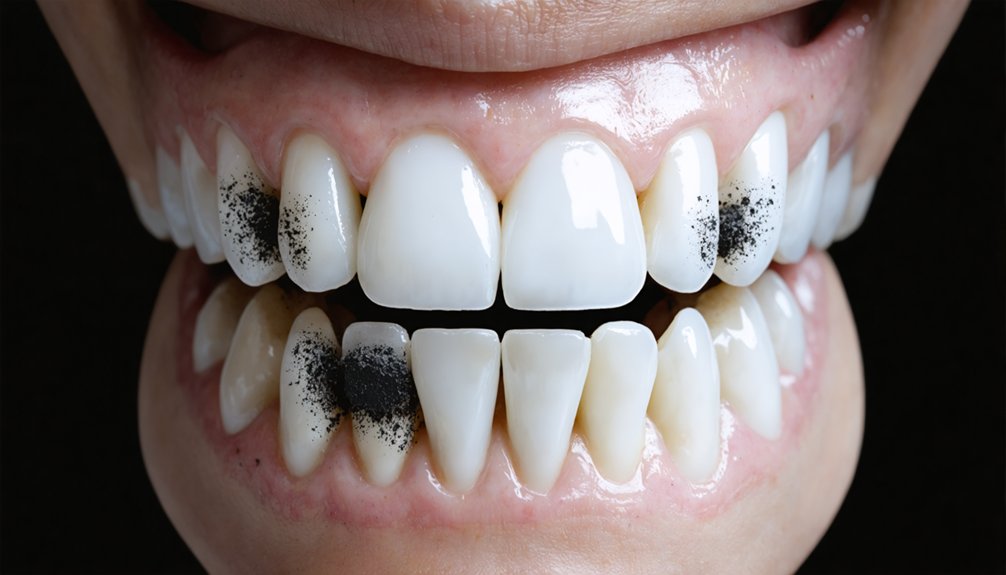Activated charcoal’s effectiveness for teeth whitening stems from its highly porous structure and natural adsorption properties. When you brush with charcoal, its microscopic particles bind to surface stains from coffee, tea, and wine through physical adhesion, while its mild abrasiveness helps lift discoloration from your enamel. However, charcoal mainly targets external stains rather than deep discoloration, and improper use can risk enamel damage. Understanding proper application techniques will help you maximize benefits while protecting your dental health.
Key Takeaways
- Activated charcoal’s highly porous structure creates maximum surface area to effectively bind and remove stain-causing compounds called chromogens.
- The natural adsorption process allows charcoal to trap and eliminate external stains from common sources like coffee, tea, and wine.
- Charcoal’s gritty texture mechanically scrubs away surface stains through gentle abrasion when applied to teeth.
- Nanocrystalline carbon in charcoal enhances its ability to physically trap organic compounds that cause tooth discoloration.
- Charcoal ions attach directly to tooth enamel, helping remove surface stains without the use of harsh chemical agents.
Understanding the Science Behind Charcoal Whitening
While teeth whitening methods continue to evolve, activated charcoal has emerged as a notable alternative based on its unique physical properties.
The science behind its effectiveness lies in the charcoal composition, which features a highly porous microscopic structure that maximizes surface area for stain adhesion. However, this abrasiveness can lead to tooth enamel damage over time. Dentists recommend seeking professional dental care instead of relying solely on charcoal products.
Activated charcoal’s microscopic network of pores creates an expansive surface area, allowing maximum contact for capturing and removing tooth stains.
You’ll find that activated charcoal works through adsorption, where stain-causing compounds called chromogens bind to its surface.
Unlike chemical whiteners, charcoal primarily targets extrinsic stains on your enamel’s surface rather than deep intrinsic discoloration.
The nanocrystalline carbon in activated charcoal enhances its ability to trap organic compounds through physical adsorption and microabrasion.
When you apply charcoal to your teeth, its ions attach to the enamel, mechanically removing surface stains without using harsh chemicals like hydrogen peroxide.
The Abrasive Power of Activated Charcoal
Although activated charcoal’s whitening properties have garnered significant attention, its abrasive nature poses notable risks to dental health.
When you use charcoal-based products, their gritty texture mechanically scrubs away surface stains, but this abrasive action comes at a cost. Due to its extreme heating process, activated charcoal develops a highly porous structure that can be too harsh for tooth enamel.
The abrasive properties of charcoal can increase your enamel’s surface roughness, making your teeth more susceptible to future staining. Over time, continuous use leads to enamel erosion, potentially exposing the yellower dentin beneath. No clinical data supports the effectiveness of charcoal for whitening teeth.
While you might notice initial whitening effects from the removal of extrinsic stains, the long-term consequences can include increased sensitivity, higher decay risk, and compromised enamel integrity.
Unlike traditional whitening products, charcoal-based options don’t address intrinsic discoloration and may lack essential protective ingredients like fluoride.
Surface Stains vs. Deep Discoloration
While activated charcoal can effectively remove external stains through its abrasive action on your teeth’s surface, you’ll find it has limited effectiveness against deeper, intrinsic discoloration that occurs within the tooth structure.
You can expect charcoal to work primarily on surface stains caused by coffee, tea, wine, and tobacco, as these substances attach to the outer layer of your teeth. Regular dental cleanings are essential for maintaining effective stain removal and preventing future discoloration. The excessive use of charcoal products can lead to enamel damage if not used properly.
For intrinsic stains caused by aging, medications, or trauma, you’ll likely need professional treatments such as dental veneers or intensive bleaching procedures.
External Stain Removal Process
Understanding how charcoal removes external stains requires examining its two primary mechanisms: adsorption and abrasive action.
When you use charcoal for teeth whitening, its highly porous surface binds to pigments and chromophores through adsorption mechanisms, lifting various stain types from your teeth’s surface.
The abrasive properties of charcoal particles physically scrub away surface discoloration as you brush. While this process effectively removes extrinsic stains from coffee, tea, and tobacco, it won’t affect deeper, intrinsic discoloration.
Since many charcoal toothpaste products lack sodium fluoride, they may increase your risk of developing cavities over time.
You’ll notice that charcoal’s whitening effect is comparable to standard whitening toothpaste, primarily because both rely on surface stain removal rather than chemical bleaching.
However, you should be aware that charcoal’s abrasiveness can potentially roughen your enamel if used excessively.
Limitations Against Deep Staining
Despite its effectiveness at removing surface stains, activated charcoal can’t address deep tooth discoloration that occurs beneath the enamel layer.
While you’ll notice improvements with extrinsic stains from coffee, tea, or tobacco, charcoal’s limitations become apparent when dealing with intrinsic discoloration caused by antibiotics, trauma, or developmental issues.
The reason for charcoal’s limited effectiveness against deep stains lies in its mechanism of action.
Charcoal works through abrasion and adsorption on the tooth’s surface, but it can’t penetrate the enamel to alter the color of underlying dentin. The large surface area of activated charcoal makes it excellent at capturing surface stains, but this property doesn’t help with deeper discoloration.
Regular use of charcoal products can cause permanent enamel damage that exposes the yellow dentin beneath.
For significant intrinsic discoloration, you’ll need professional treatments that use chemical agents like hydrogen peroxide, which can actually modify tooth structure at the molecular level.
Clinical studies consistently show that charcoal-based products offer no advantage over conventional whitening toothpaste for deep stains.
Safety Considerations for Tooth Enamel
Although activated charcoal has gained popularity as a teeth whitening method, its abrasive properties pose significant risks to tooth enamel integrity.
When you use charcoal-based toothpaste regularly, you’re fundamentally scrubbing away your enamel through mechanical abrasion. This erosion is permanent, as tooth enamel doesn’t regenerate naturally.
The consequences of enamel erosion extend beyond cosmetic concerns. You’ll likely experience increased tooth sensitivity as the protective enamel layer thins, exposing the underlying dentin.
Additionally, your teeth become more vulnerable to decay and cavities. Many users report that charcoal toothpaste leaves stains around edges of teeth. The abrasive nature of charcoal can also lead to gum sensitivity and recession, potentially requiring professional intervention.
Without the protective benefits of fluoride found in conventional toothpaste, your teeth face even greater risk of damage from acid attacks and decay.
Comparing Charcoal to Traditional Whitening Methods

When you compare charcoal and traditional peroxide-based whitening methods, you’ll find that peroxide treatments consistently demonstrate superior clinical results through their chemical alteration of intrinsic stains.
While charcoal products rely on mechanical abrasion to remove surface stains, peroxide-based whiteners penetrate deeper into tooth structure to break down discoloration molecules.
Although charcoal products market themselves as natural alternatives, their whitening effects are typically less profound and more variable than traditional peroxide methods, which have established protocols and documented efficacy.
Clinical Results vs. Peroxide
Based on extensive clinical trials comparing tooth whitening methods, peroxide-based treatments consistently outperform charcoal products in both efficacy and measurable results.
While charcoal effectiveness relies primarily on surface-level stain removal through abrasive action, peroxide superiority is evident in its ability to chemically alter both intrinsic and extrinsic stains at a molecular level.
Clinical data demonstrates that peroxide treatments achieve significant, quantifiable improvements in tooth color parameters, whereas charcoal products show minimal or negligible changes.
You’ll find that peroxide whitening produces more predictable outcomes, though it may cause temporary sensitivity.
In contrast, charcoal’s abrasive nature poses risks of permanent enamel damage.
Patient satisfaction ratings consistently favor peroxide-based treatments, with users reporting better results and easier application compared to charcoal alternatives.
Natural vs. Chemical Whitening
Natural teeth whitening methods like charcoal have gained popularity among consumers seeking alternatives to chemical treatments, yet scientific evidence strongly favors traditional peroxide-based approaches.
While natural ingredients appeal to health-conscious individuals, consumer awareness about safety and efficacy is essential.
Consider these evidence-based comparisons:
- Peroxide-based treatments consistently demonstrate superior whitening results, especially for deep stains, while charcoal only affects surface discoloration.
- Chemical whitening methods undergo rigorous safety testing and regulation, whereas many natural alternatives lack scientific validation.
- Traditional treatments cause minimal enamel damage when used as directed, but charcoal’s abrasiveness can harm tooth structure.
- Although natural methods may seem gentler, peroxide whitening delivers more predictable outcomes with lower risks of complications.
Best Practices for Using Charcoal Toothpaste
Although charcoal toothpaste has gained popularity as a natural whitening method, using it safely requires following specific guidelines to protect your dental health.
For ideal charcoal usage, apply a pea-sized amount to a soft-bristled toothbrush and brush gently for no more than two minutes. Avoid aggressive scrubbing, as this can damage your enamel.
When implementing whitening techniques with charcoal, limit applications to occasional use rather than daily brushing. Always rinse thoroughly after use to remove all residue, and don’t swallow the paste.
Since most charcoal toothpastes lack fluoride, it’s crucial to maintain regular brushing with standard fluoride toothpaste. If you notice increased tooth sensitivity or discomfort, discontinue use and consult your dentist for alternative whitening options.
Long-Term Effects on Dental Health

While charcoal teeth whitening may offer short-term cosmetic benefits, its long-term effects on dental health raise significant concerns among dental professionals. The abrasive nature of charcoal can lead to serious dental complications that you’ll need to reflect upon before incorporating it into your oral care routine.
- Your enamel degradation becomes permanent and irreversible, exposing the yellowish dentin beneath.
- You’ll experience increased long-term sensitivity to hot, cold, and sweet stimuli.
- Your teeth become more susceptible to plaque buildup and decay due to roughened enamel surfaces.
- Your gum health may deteriorate, potentially leading to recession and the need for restorative treatments.
These effects are particularly concerning for those with pre-existing dental conditions, and you should consult your dental professional before using charcoal-based products.
Frequently Asked Questions
Can Charcoal Whitening Remove Stains Caused by Medications or Medical Conditions?
Don’t get your hopes up – charcoal won’t touch those deep medication stains or medical conditions affecting your teeth. It only works on surface stains through abrasion, not intrinsic discoloration below the enamel.
How Long Should I Wait After Professional Dental Work Before Using Charcoal?
You should consult your dentist for specific guidance, as there’s no standard waiting period. Due to charcoal safety concerns and potential dental sensitivity, it’s essential to get personalized professional advice.
Does Charcoal Whitening Affect Dental Crowns, Veneers, or Tooth-Colored Fillings?
Like a shadow that won’t budge, charcoal won’t whiten your dental restorations. Instead, it can stain margins, weaken bonding materials, and create micro-scratches on crowns, veneers, and fillings.
Can Children or Teenagers Safely Use Charcoal Whitening Products?
You shouldn’t use charcoal whitening products if you’re under 18 due to safety concerns. Age restrictions exist because these abrasive products can damage developing teeth and cause permanent enamel loss.
Will Charcoal Whitening Interfere With Upcoming Dental X-Rays or Treatments?
While charcoal particles won’t cloud your x-ray’s clarity like storm clouds, you should brush thoroughly before any dental visits to prevent treatment scheduling complications or interference with procedures.
References
- https://pubmed.ncbi.nlm.nih.gov/36183933/
- https://pmc.ncbi.nlm.nih.gov/articles/PMC10351494/
- https://www.todaysrdh.com/activated-charcoal-in-toothpaste-systematic-review-looks-at-whitening-and-abrasive-effects/
- https://www.health.harvard.edu/staying-healthy/is-charcoal-toothpaste-safe-for-my-teeth
- https://www.eurekabiomedical.com/index.php/EHI/article/view/80
- https://jdsits.in/archive/volume/13/issue/1/article/10215/pdf
- https://pmc.ncbi.nlm.nih.gov/articles/PMC10024105/
- https://wewhiten.com/activated-charcoal-teeth-whitening/
- https://www.oldsettlersdental.com/demystifying-charcoal-teeth-whitening-all-you-need-to-know/
- https://www.ada.org/resources/ada-library/oral-health-topics/whitening



